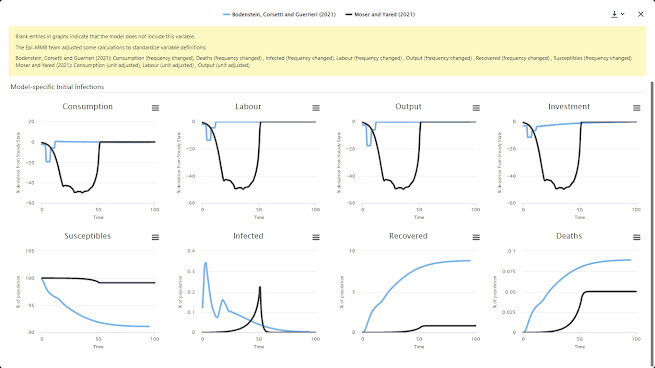Heterogeneity in SIR-macro?
Eichenbaum et al. (2020) developed a “SIR-macro” model which is often used as a basis in the recent highly developed literature on covid pandemic. The model embeds a simple economy with the epidemiological SIR part based on Kermack and McKendrick (1927). In reality, the pandemic spread with heterogeneity - including age, region and occupation. Appropriate policy responses should take these heterogeneities into consideration.
What to do on the epi-mmb?
- Model: ERT_21_NK, GP_20, KUX_20, CF_20
- Shocks: Initial infections of 0.1% of the population
- Variables: Consumption, Labour, Output, Susceptibles, Infected, Deaths
These models are based on ERT_21_NK, but slightly differ in several dimensions. GP_20 incorporates age-specific socio-economic interactions to study the role of demographic factors in the COVID-19 epidemic evolution, KUX_20 features heterogeneous production sectors of consumption goods, and CF_20 added multiple locations and travel cost to the model to study the optimal implementation of stay-at-home orders.
With heterogeneities the models show differentiated results and, hence, policy implications. For CF_20 with multiple regions, due to the travel cost across regions the peak infection comes later and milder, so does the decrease in output. For GP_20 featuring age groups with different infectious and death rates, the model predicts more deaths and sharper recession that peaks at later periods. For KUX_20 with heterogeneous production sectors, without private households relocating consumption activity to the less infectious sector, the disease explodes at the very beginning. It would be interesting to see how policies should accomodate these heterogenities.
Reference: Eichenbaum, Rebelo and Trabandt (2021), Giagheddu and Papetti (2020), Krüger, Uhlig and Xi (2020), Crucini and O'Flaherty (2020)

Comments
Post a Comment